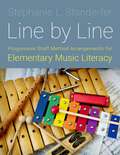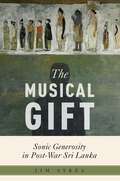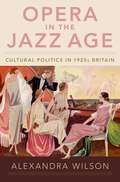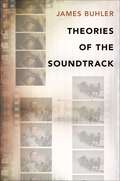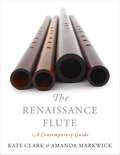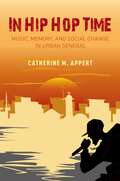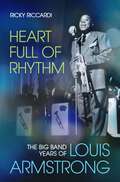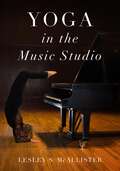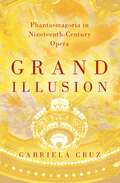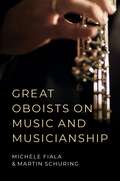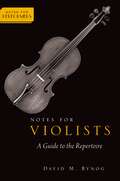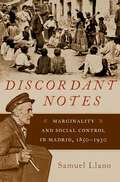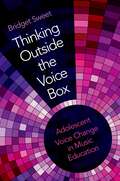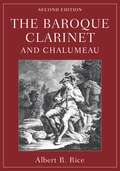- Table View
- List View
LINE BY LINE C: Progressive Staff Method Arrangements for Elementary Music Literacy
by Stephanie L. StanderferIn Line by Line, author Stephanie L. Standerfer harnesses years of pedagogical expertise in a practical guide to promote music learning by experience rather than imitation and memorization. Using well-known songs and a variety of instrumental accompaniments for all skill levels, lesson plans encourage students to first learn music conceptually by internalizing the sound and feeling before learning musical symbols. The lesson plans are tailored for five to seven spiraled class periods and take every student into consideration by suggesting ways to address specific student needs for those who need more time to process.
The Musical Gift: Sonic Generosity in Post-War Sri Lanka (Critical Conjunctures in Music and Sound)
by Jim SykesThe Musical Gift tells Sri Lanka's music history as a story of giving between humans and nonhumans, and between populations defined by difference. Author Jim Sykes argues that in the recent past, the genres we recognize today as Sri Lanka's esteemed traditional musics were not originally about ethnic or religious identity, but were gifts to gods and people intended to foster protection and/or healing. Noting that the currently assumed link between music and identity helped produce the narratives of ethnic difference that drove Sri Lanka's civil war (1983-2009), Sykes argues that the promotion of connected music histories has a role to play in post-war reconciliation. The Musical Gift includes a study of how NGOs used music to promote reconciliation in Sri Lanka, and it contains a theorization of the relations between musical gifts and commodities. Eschewing a binary between the gift and identity, Sykes claims the world's music history is largely a story of entanglement between both paradigms. Drawing on fieldwork conducted widely across Sri Lanka over a span of eleven years--including the first study of Sinhala Buddhist drumming in English and the first ethnography of music-making in the former warzones of the north and east--this book brings anthropology's canonic literature on "the gift" into music studies, while drawing on anthropology's recent "ontological turn" and "the new materialism" in religious studies.
MUSICAL GIFT CCMS C: Sonic Generosity in Post-War Sri Lanka (Critical Conjunctures in Music and Sound)
by Jim SykesThe Musical Gift tells Sri Lanka's music history as a story of giving between humans and nonhumans, and between populations defined by difference. Author Jim Sykes argues that in the recent past, the genres we recognize today as Sri Lanka's esteemed traditional musics were not originally about ethnic or religious identity, but were gifts to gods and people intended to foster protection and/or healing. Noting that the currently assumed link between music and identity helped produce the narratives of ethnic difference that drove Sri Lanka's civil war (1983-2009), Sykes argues that the promotion of connected music histories has a role to play in post-war reconciliation. The Musical Gift includes a study of how NGOs used music to promote reconciliation in Sri Lanka, and it contains a theorization of the relations between musical gifts and commodities. Eschewing a binary between the gift and identity, Sykes claims the world's music history is largely a story of entanglement between both paradigms. Drawing on fieldwork conducted widely across Sri Lanka over a span of eleven years--including the first study of Sinhala Buddhist drumming in English and the first ethnography of music-making in the former warzones of the north and east--this book brings anthropology's canonic literature on "the gift" into music studies, while drawing on anthropology's recent "ontological turn" and "the new materialism" in religious studies.
Opera in the Jazz Age: Cultural Politics in 1920s Britain
by Alexandra WilsonJazz, the Charleston, nightclubs, cocktails, cinema, and musical theatre: 1920s British nightlife was vibrant and exhilarating. But where did opera fit into this fashionable new entertainment world? Opera in the Jazz Age: Cultural Politics in 1920s Britain explores the interaction between opera and popular culture at a key historical moment when there was a growing imperative to categorize art forms as "highbrow," "middlebrow," or "lowbrow." Literary studies of the so-called "battle of the brows" have been numerous, but this is the first book to consider the place of opera in interwar debates about high and low culture. This study by Alexandra Wilson argues that opera was extremely difficult to pigeonhole: although some contemporary commentators believed it to be too highbrow, others thought it not highbrow enough. Opera in the Jazz Age paints a lively and engaging picture of 1920s operatic culture, and introduces a charismatic cast of early twentieth-century critics, conductors, and celebrity singers. Opera was performed during this period to socially mixed audiences in a variety of spaces beyond the conventional opera house: music halls, cinemas, cafés and schools. Performance and production standards were not always high - often quite the reverse - but opera-going was evidently great fun. Office boys whistled operatic tunes they had heard on the gramophone and there was a genuine sense that opera was for everyone. In this provocative and timely study, Wilson considers how the opera debate of the 1920s continues to shape the ways in which we discuss the art form, and draws connections between the battle of the brows and present-day discussions about elitism. The book makes a major contribution to our understanding of the cultural politics of twentieth-century Britain and is essential reading for anybody interested in the history of opera, the battle of the brows, or simply the perennially fascinating decade that was the 1920s.
Opera in the Jazz Age: Cultural Politics in 1920s Britain
by Alexandra WilsonJazz, the Charleston, nightclubs, cocktails, cinema, and musical theatre: 1920s British nightlife was vibrant and exhilarating. But where did opera fit into this fashionable new entertainment world? Opera in the Jazz Age: Cultural Politics in 1920s Britain explores the interaction between opera and popular culture at a key historical moment when there was a growing imperative to categorize art forms as "highbrow," "middlebrow," or "lowbrow." Literary studies of the so-called "battle of the brows" have been numerous, but this is the first book to consider the place of opera in interwar debates about high and low culture. This study by Alexandra Wilson argues that opera was extremely difficult to pigeonhole: although some contemporary commentators believed it to be too highbrow, others thought it not highbrow enough. Opera in the Jazz Age paints a lively and engaging picture of 1920s operatic culture, and introduces a charismatic cast of early twentieth-century critics, conductors, and celebrity singers. Opera was performed during this period to socially mixed audiences in a variety of spaces beyond the conventional opera house: music halls, cinemas, cafés and schools. Performance and production standards were not always high - often quite the reverse - but opera-going was evidently great fun. Office boys whistled operatic tunes they had heard on the gramophone and there was a genuine sense that opera was for everyone. In this provocative and timely study, Wilson considers how the opera debate of the 1920s continues to shape the ways in which we discuss the art form, and draws connections between the battle of the brows and present-day discussions about elitism. The book makes a major contribution to our understanding of the cultural politics of twentieth-century Britain and is essential reading for anybody interested in the history of opera, the battle of the brows, or simply the perennially fascinating decade that was the 1920s.
Theories of the Soundtrack (Oxford Music/Media Series)
by James BuhlerA theory of the soundtrack is concerned with what belongs to the soundtrack, how a soundtrack is effectively organized, how its status in a multimedia object affects the nature of the object, the tools available for its analysis, and the interpretive regime that the theory mandates for determining the meaning, sense, and structure that sound and music bring to film and other audiovisual media. Beyond that, a theory may also delineate the range of possible uses of sound and music, classify the types of relations that films have used for image and sound, identify the central problems, and reflect on and describe effective uses of sound in film. This book summarizes and critiques major theories of the soundtrack from roughly 1929 until today. Rather than providing an exhaustive historical survey, it sketches out the range of theoretical approaches that have been applied to the soundtrack since the commercial introduction of the sound film. The basic theoretical framework of each approach is presented, taking into account the explicit and implicit claims about the soundtrack and its relation to other theories. The organization is both chronological and topical, the former in that the chapters move steadily from early film theory through models of the classical system to more recent critical theories; the latter in that the chapters highlight central issues for each generation: the problem of film itself, then of image and sound, of adequate analytical-descriptive models, and finally of critical-interpretative models.
The Renaissance Flute: A Contemporary Guide
by Kate Clark Amanda MarkwickThe renaissance flute, with its rich history, stunning repertoire, and mellow tone, has attracted a significant following among flutists, whether they specialize in modern flute or historical instruments. Yet, actually delving into the study of renaissance flute has proven a challenge - there exists a confusing array of editions of renaissance music, specialized (and often expensive) facsimiles of manuscripts and early prints, and in unfamiliar notations, while at the same time there is a dearth of resources for beginners. Confronting this challenge with the first ever practitioners' handbook for renaissance flute, Kate Clark and Amanda Markwick offer flutists of all levels a clear and accessible introduction to the world and repertoire of the instrument. In The Renaissance Flute: A Contemporary Guide, Clark and Markwick cover all aspects, from practicalities such as buying and maintaining the instrument, to actual music for solo and group performance, to theory designed to improve the understanding and playing of renaissance polyphony. This approach enables students to immerse themselves at their own pace and build on their skills with each chapter. With nearly 40 full pages of exercises, and a companion website with recorded examples and filmed instructions from the authors, The Renaissance Flute provides professionals and newcomers alike a new entryway into the world and practice of renaissance music.
The Renaissance Flute: A Contemporary Guide
by Kate Clark Amanda MarkwickThe renaissance flute, with its rich history, stunning repertoire, and mellow tone, has attracted a significant following among flutists, whether they specialize in modern flute or historical instruments. Yet, actually delving into the study of renaissance flute has proven a challenge - there exists a confusing array of editions of renaissance music, specialized (and often expensive) facsimiles of manuscripts and early prints, and in unfamiliar notations, while at the same time there is a dearth of resources for beginners. Confronting this challenge with the first ever practitioners' handbook for renaissance flute, Kate Clark and Amanda Markwick offer flutists of all levels a clear and accessible introduction to the world and repertoire of the instrument. In The Renaissance Flute: A Contemporary Guide, Clark and Markwick cover all aspects, from practicalities such as buying and maintaining the instrument, to actual music for solo and group performance, to theory designed to improve the understanding and playing of renaissance polyphony. This approach enables students to immerse themselves at their own pace and build on their skills with each chapter. With nearly 40 full pages of exercises, and a companion website with recorded examples and filmed instructions from the authors, The Renaissance Flute provides professionals and newcomers alike a new entryway into the world and practice of renaissance music.
In Hip Hop Time: Music, Memory, and Social Change in Urban Senegal
by Catherine M. AppertIn the twenty-first century, Senegalese hip hop--"Rap Galsen"--has reverberated throughout the world as an exemplar of hip hop resistance in its mobilization against government corruption during a series of tumultuous presidential elections. Yet Senegalese hip hop's story goes beyond resistance; it is a story of globalization, of diasporic movement and memory, of imagined African pasts and contemporary African realities, and of urbanization and the banality of socio-economic struggle. At particular moments in Rap Galsen's history, origin narratives linked hip hop to a mythologized Africa through the sounds of indigenous oralities. At other times, contrasting narratives highlighted hip hop's equally mythologized roots in the postindustrial U.S. inner city and African American experience. As Senegalese youth engage these globally circulating narratives, hip hop performance and its stories negotiate their place in a rapidly changing world. In Hip Hop Time explores this relationship between popular music and social change, framing Senegalese hip hop as a musical movement deeply tied to both indigenous performance practices and changing social norms in urban Africa. Author Catherine Appert takes us from Senegalese hip hop's beginnings among cosmopolitan youth in Dakar's affluent neighborhoods in the 1980s, to its spread throughout the city's ghettoized working class neighborhoods in the mid- to late-'90s, and into the present day, where political activism and hip hop musicality vie for position in local and global arenas. An ethnography of the inextricability of musical and social meaning in hip hop practice, In Hip Hop Time charts new intellectual territory in the scholarship of African and global hip hop.
IN HIP HOP TIME C: Music, Memory, and Social Change in Urban Senegal
by Catherine M. AppertIn the twenty-first century, Senegalese hip hop--"Rap Galsen"--has reverberated throughout the world as an exemplar of hip hop resistance in its mobilization against government corruption during a series of tumultuous presidential elections. Yet Senegalese hip hop's story goes beyond resistance; it is a story of globalization, of diasporic movement and memory, of imagined African pasts and contemporary African realities, and of urbanization and the banality of socio-economic struggle. At particular moments in Rap Galsen's history, origin narratives linked hip hop to a mythologized Africa through the sounds of indigenous oralities. At other times, contrasting narratives highlighted hip hop's equally mythologized roots in the postindustrial U.S. inner city and African American experience. As Senegalese youth engage these globally circulating narratives, hip hop performance and its stories negotiate their place in a rapidly changing world. In Hip Hop Time explores this relationship between popular music and social change, framing Senegalese hip hop as a musical movement deeply tied to both indigenous performance practices and changing social norms in urban Africa. Author Catherine Appert takes us from Senegalese hip hop's beginnings among cosmopolitan youth in Dakar's affluent neighborhoods in the 1980s, to its spread throughout the city's ghettoized working class neighborhoods in the mid- to late-'90s, and into the present day, where political activism and hip hop musicality vie for position in local and global arenas. An ethnography of the inextricability of musical and social meaning in hip hop practice, In Hip Hop Time charts new intellectual territory in the scholarship of African and global hip hop.
Heart Full of Rhythm: The Big Band Years of Louis Armstrong
by Ricky RiccardiNearly 50 years after his death, Louis Armstrong remains one of the 20th century's most iconic figures. Popular fans still appreciate his later hits such as "Hello, Dolly!" and "What a Wonderful World," while in the jazz community, he remains venerated for his groundbreaking innovations in the 1920s. The achievements of Armstrong's middle years, however, possess some of the trumpeter's most scintillating and career-defining stories. But the story of this crucial time has never been told in depth until now. Between 1929 and 1947, Armstrong transformed himself from a little-known trumpeter in Chicago to an internationally renowned pop star, setting in motion the innovations of the Swing Era and Bebop. He had a similar effect on the art of American pop singing, waxing some of his most identifiable hits such as "Jeepers Creepers" and "When You're Smiling." However as author Ricky Riccardi shows, this transformative era wasn't without its problems, from racist performance reviews and being held up at gunpoint by gangsters to struggling with an overworked embouchure and getting arrested for marijuana possession. Utilizing a prodigious amount of new research, Riccardi traces Armstrong's mid-career fall from grace and dramatic resurgence. Featuring never-before-published photographs and stories culled from Armstrong's personal archives, Heart Full of Rhythm tells the story of how the man called "Pops" became the first "King of Pop."
Heart Full of Rhythm: The Big Band Years of Louis Armstrong
by Ricky RiccardiNearly 50 years after his death, Louis Armstrong remains one of the 20th century's most iconic figures. Popular fans still appreciate his later hits such as "Hello, Dolly!" and "What a Wonderful World," while in the jazz community, he remains venerated for his groundbreaking innovations in the 1920s. The achievements of Armstrong's middle years, however, possess some of the trumpeter's most scintillating and career-defining stories. But the story of this crucial time has never been told in depth until now. Between 1929 and 1947, Armstrong transformed himself from a little-known trumpeter in Chicago to an internationally renowned pop star, setting in motion the innovations of the Swing Era and Bebop. He had a similar effect on the art of American pop singing, waxing some of his most identifiable hits such as "Jeepers Creepers" and "When You're Smiling." However as author Ricky Riccardi shows, this transformative era wasn't without its problems, from racist performance reviews and being held up at gunpoint by gangsters to struggling with an overworked embouchure and getting arrested for marijuana possession. Utilizing a prodigious amount of new research, Riccardi traces Armstrong's mid-career fall from grace and dramatic resurgence. Featuring never-before-published photographs and stories culled from Armstrong's personal archives, Heart Full of Rhythm tells the story of how the man called "Pops" became the first "King of Pop."
Yoga in the Music Studio
by Lesley S. McAllisterYoga in the Music Studio brings the popular and beneficial practice of yoga to music teachers and students of all instruments and ages, from preschoolers to senior adults and all those in-between. Expert on mind-body techniques Lesley S. McAllister provides a unique opportunity for all to improve their musical craft, enabling teachers to help their students concentrate, listen more attentively, relax, and play their best - whether before a performance or just during lessons - all through the practice of yoga. Many music teachers know that yoga postures and breathing practices can help musicians achieve peak performance, prevent injury, and relieve pain, yet surprisingly few are themselves familiar with these techniques or know how to introduce them to their students. McAllister welcomes the music teacher into the philosophy and history of yoga, introducing them to the research behind yoga's physical and emotional benefits. Step-by-step illustrations of practical stretches and useful poses then guide the teacher to the yoga practices that suit their individual needs and those of their students. An accessible and comprehensive yoga curriculum, Yoga in the Music Studio will help to improve students' musicianship, while contributing to their lifelong health and wellness.
YOGA IN THE MUSIC STUDIO C
by Lesley S. McAllisterYoga in the Music Studio brings the popular and beneficial practice of yoga to music teachers and students of all instruments and ages, from preschoolers to senior adults and all those in-between. Expert on mind-body techniques Lesley S. McAllister provides a unique opportunity for all to improve their musical craft, enabling teachers to help their students concentrate, listen more attentively, relax, and play their best - whether before a performance or just during lessons - all through the practice of yoga. Many music teachers know that yoga postures and breathing practices can help musicians achieve peak performance, prevent injury, and relieve pain, yet surprisingly few are themselves familiar with these techniques or know how to introduce them to their students. McAllister welcomes the music teacher into the philosophy and history of yoga, introducing them to the research behind yoga's physical and emotional benefits. Step-by-step illustrations of practical stretches and useful poses then guide the teacher to the yoga practices that suit their individual needs and those of their students. An accessible and comprehensive yoga curriculum, Yoga in the Music Studio will help to improve students' musicianship, while contributing to their lifelong health and wellness.
Grand Illusion: Phantasmagoria in Nineteenth-Century Opera
by Gabriela CruzA new and groundbreaking approach to the history of grand opera, Grand Illusion: Phantasmagoria in Nineteenth-Century Opera explores the illusion and illumination behind the form's rise to cultural eminence. Renowned opera scholar Gabriela Cruz argues that grand opera worked to awaken memory and feeling in a way never before experienced in the opera house, asserting that the concept of "spectacle" was the defining cultural apparatus of the art form after the 1820s. Parisian audiences at the Académie Royale de Musique were struck by the novelty and power of grand opera upon the introduction of gaslight illumination, a technological innovation that quickly influenced productions across the Western operatic world. With this innovation, grand opera transformed into an audio-visual spectacle, delivering dream-like images and evoking the ghosts of its audiences' past. Through case studies of operas by Giacomo Meyerbeer, Richard Wagner, and Giuseppe Verdi, Cruz demonstrates how these works became an increasingly sophisticated medium by which audiences could conjure up the past and be transported away from the breakdown of modern life. A historically informed narrative that traverses far and wide, from dingy popular theatres in post-revolutionary Paris, to nautical shows in London, and finally to Egyptian mummies, Grand Illusion provides a fresh departure from previous scholarship, highlighting the often-neglected visual side of grand opera.
Grand Illusion: Phantasmagoria in Nineteenth-Century Opera
by Gabriela CruzA new and groundbreaking approach to the history of grand opera, Grand Illusion: Phantasmagoria in Nineteenth-Century Opera explores the illusion and illumination behind the form's rise to cultural eminence. Renowned opera scholar Gabriela Cruz argues that grand opera worked to awaken memory and feeling in a way never before experienced in the opera house, asserting that the concept of "spectacle" was the defining cultural apparatus of the art form after the 1820s. Parisian audiences at the Académie Royale de Musique were struck by the novelty and power of grand opera upon the introduction of gaslight illumination, a technological innovation that quickly influenced productions across the Western operatic world. With this innovation, grand opera transformed into an audio-visual spectacle, delivering dream-like images and evoking the ghosts of its audiences' past. Through case studies of operas by Giacomo Meyerbeer, Richard Wagner, and Giuseppe Verdi, Cruz demonstrates how these works became an increasingly sophisticated medium by which audiences could conjure up the past and be transported away from the breakdown of modern life. A historically informed narrative that traverses far and wide, from dingy popular theatres in post-revolutionary Paris, to nautical shows in London, and finally to Egyptian mummies, Grand Illusion provides a fresh departure from previous scholarship, highlighting the often-neglected visual side of grand opera.
Great Oboists on Music and Musicianship
by Michele L. Fiala Martin SchuringWhat do the world's most prominent oboists have to say about their musical ideas, performance techniques, and teaching strategies? Michele L. Fiala and Martin Schuring, themselves skilled oboists, undertook the project of asking twenty-six of them about their musicianship and pedagogy. The results are collected in Great Oboists on Music and Musicianship, which provides a unique window into how these virtuosi of wind instruments think about their craft. Each chapter paints an engaging portrait of a leading oboist that allows them to share--in their own words--their insights on the performance techniques, learning strategies, and career moves that propelled them to their current stature. The captivating prose chapters that Fiala and Schuring composed from the interviews allow each artist's personality to shine through as they convey their hard-won wisdom on topics such as musical interpretation, the relationship between vocal and instrumental music, being a good ensemble player, and warm-up routines. The diverse array of musicians portrayed in this book includes orchestral and solo performers from across North America, Europe, and Australia. Their practical advice will resonate not just with oboists but also with players and teachers of other instruments as they pursue their own musical journeys.
Great Oboists on Music and Musicianship
by Michele L. Fiala Martin SchuringWhat do the world's most prominent oboists have to say about their musical ideas, performance techniques, and teaching strategies? Michele L. Fiala and Martin Schuring, themselves skilled oboists, undertook the project of asking twenty-six of them about their musicianship and pedagogy. The results are collected in Great Oboists on Music and Musicianship, which provides a unique window into how these virtuosi of wind instruments think about their craft. Each chapter paints an engaging portrait of a leading oboist that allows them to share--in their own words--their insights on the performance techniques, learning strategies, and career moves that propelled them to their current stature. The captivating prose chapters that Fiala and Schuring composed from the interviews allow each artist's personality to shine through as they convey their hard-won wisdom on topics such as musical interpretation, the relationship between vocal and instrumental music, being a good ensemble player, and warm-up routines. The diverse array of musicians portrayed in this book includes orchestral and solo performers from across North America, Europe, and Australia. Their practical advice will resonate not just with oboists but also with players and teachers of other instruments as they pursue their own musical journeys.
Notes for Violists: A Guide to the Repertoire (Notes for Performers)
by David M. BynogNotes for Violists: A Guide to the Repertoire offers historical and analytical information about thirty-five of the best-known pieces for the instrument, making it an essential resource for professional, amateur, and student violists alike. With engaging prose supported by fact-filled analytical charts, the book offers rich biographical information and insightful analyses that help violists gain a more complete understanding of pieces like Béla Bartók's Concerto for Viola and Orchestra, Rebecca Clarke's Sonata for Viola and Piano, Robert Schumann's Märchenbilder for Viola and Piano, op. 113, Carl Stamitz's Concerto for Viola and Orchestra in D Major, Igor Stravinsky's Élégie for Viola or Violin Unaccompanied, and thirty other masterpieces. This comprehensive guide to key pieces from the viola repertoire from the eighteenth through the twentieth century covers concertos, chamber pieces, and works for solo viola by a wide range of composers, including Bach, Telemann, Mozart, Hoffmeister, Walton, and Hindemith. Author David M. Bynog not only offers clear structural analyses of these compositions but also situates them in their historical contexts as he highlights crucial biographical information on composers and explores the circumstances of the development and performance of each work. By connecting performance studies with scholarship, this indispensable handbook for students and professionals allows readers to gain a more complete picture of each work and encourages them to approach other compositions in a similarly analytical manner.
Notes for Violists: A Guide to the Repertoire (Notes for Performers)
by David M. BynogNotes for Violists: A Guide to the Repertoire offers historical and analytical information about thirty-five of the best-known pieces for the instrument, making it an essential resource for professional, amateur, and student violists alike. With engaging prose supported by fact-filled analytical charts, the book offers rich biographical information and insightful analyses that help violists gain a more complete understanding of pieces like Béla Bartók's Concerto for Viola and Orchestra, Rebecca Clarke's Sonata for Viola and Piano, Robert Schumann's Märchenbilder for Viola and Piano, op. 113, Carl Stamitz's Concerto for Viola and Orchestra in D Major, Igor Stravinsky's Élégie for Viola or Violin Unaccompanied, and thirty other masterpieces. This comprehensive guide to key pieces from the viola repertoire from the eighteenth through the twentieth century covers concertos, chamber pieces, and works for solo viola by a wide range of composers, including Bach, Telemann, Mozart, Hoffmeister, Walton, and Hindemith. Author David M. Bynog not only offers clear structural analyses of these compositions but also situates them in their historical contexts as he highlights crucial biographical information on composers and explores the circumstances of the development and performance of each work. By connecting performance studies with scholarship, this indispensable handbook for students and professionals allows readers to gain a more complete picture of each work and encourages them to approach other compositions in a similarly analytical manner.
Discordant Notes: Marginality and Social Control in Madrid, 1850-1930 (Currents in Latin American and Iberian Music)
by Samuel LlanoScholarship on urban culture and the senses has traditionally focused on the study of literature and the visual arts. Recent decades have seen a surge of interest on the effects of sound the urban space and its population. These studies analyse how sound generates identities that are often fragmentary and mutually conflicting. They also explore the ways in which sound triggers campaigns against the negative effects of noise on the nerves and health of the population. Little research has been carried out about the impact of sound and music in areas of broader social and political concern such as social aid, hygiene and social control. Based on a detailed study of Madrid from the 1850s to the 1930s, Discordant Notes argues that sound and music have played a key role in structuring the transition to modernity by helping to negotiate social attitudes and legal responses to problems such as poverty, insalubrity, and crime. Attempts to control the social groups that own unwanted musical practices such as organ grinding and flamenco performances in taverns raised awareness about public hygiene, alcoholism and crime, and triggered legal reform in these areas. In addition to scapegoating, marginalising and persecuting these musical practices, the authorities and the media used workhouse bands as instruments of social control to spread "aural hygiene" across the city.
Thinking Outside the Voice Box: Adolescent Voice Change in Music Education
by Bridget SweetThe changing adolescent voice counts among the most awkward of topics voice teachers and choir directors face. Adolescent voice students already find themselves at a volatile developmental time in their lives, and the stresses and possible embarrassments of unpredictable vocal capabilities make participation in voice-based music an especially fraught event. In this practical teaching guide, author Bridget Sweet encourages a holistic approach to female and male adolescent voice change. Sweet's approach takes full consideration of the body, brain, and auditory system; vocal anatomy and physiology in general, as well as during male and female voice change; and the impact of hormones on the adolescent voice, especially for female singers. Beyond the physical, it also addresses the emotional and psychological components: ideas of resolve and perseverance that are essential to adolescent navigation of voice change; and exploration of portrayals and stereotypes in pop culture that influence how people anticipate voice change experiences for teens and 'tweens, from The Brady Bunch to The Wonder Years to The Simpsons. As a whole, Teaching Outside the Voice Box encourages music educators to more effectively and compassionately assist students through this developmental experience.
Thinking Outside the Voice Box: Adolescent Voice Change in Music Education
by Bridget SweetThe changing adolescent voice counts among the most awkward of topics voice teachers and choir directors face. Adolescent voice students already find themselves at a volatile developmental time in their lives, and the stresses and possible embarrassments of unpredictable vocal capabilities make participation in voice-based music an especially fraught event. In this practical teaching guide, author Bridget Sweet encourages a holistic approach to female and male adolescent voice change. Sweet's approach takes full consideration of the body, brain, and auditory system; vocal anatomy and physiology in general, as well as during male and female voice change; and the impact of hormones on the adolescent voice, especially for female singers. Beyond the physical, it also addresses the emotional and psychological components: ideas of resolve and perseverance that are essential to adolescent navigation of voice change; and exploration of portrayals and stereotypes in pop culture that influence how people anticipate voice change experiences for teens and 'tweens, from The Brady Bunch to The Wonder Years to The Simpsons. As a whole, Teaching Outside the Voice Box encourages music educators to more effectively and compassionately assist students through this developmental experience.
The Baroque Clarinet and Chalumeau
by Albert R. RiceThe first edition of Albert R. Rice's The Baroque Clarinet is widely considered the authoritative text on the European clarinet during the first half of the eighteenth century. Since its publication in 1992, its conclusions have influenced the approaches of musicologists, instrument historians, and clarinet performers. Twenty-eight years later, Rice has updated his renowned study in a second edition, with new chapters on chalumeau and clarinet music, insights on newly found instruments and additional material on the Baroque clarinet in society. Expanding the volume to include the chalumeau, close cousin and predecessor to the clarinet, Rice draws on nearly three decades of new research on the instrument's origins and music. Discoveries include two recently found chalumeaux in a private collection, one by Johann Heinrich Eichentopf of Leipzig, and attributions based on historical evidence for three more chalumeaux. Rice furthers the discussion to recently uncovered early instruments and historical scores, which shed light on the clarinet's evolution. Most essentially, Rice highlights the chalumeau's substantial late-seventeenth and early-eighteenth century repertory, comprising over 330 works by 66 composers, and includes a more expansive list of surviving Baroque clarinet works, organized by date, composer, and tonality/range. The Baroque Clarinet and Chalumeau provides a long-awaited follow-up to Rice's groundbreaking volume, drawing from a variety of sources-including German, Italian, Dutch, Swedish, Norwegian, Danish, Finnish, Flemish, Czech, and Catalan research-to bring this new information to an English-speaking audience. With his dedication to scholarly accuracy, Rice brings the Baroque clarinet into sharper focus than ever before.
BAROQUE CLARINET & CHALUMEAU 2E C
by Albert R. RiceThe first edition of Albert R. Rice's The Baroque Clarinet is widely considered the authoritative text on the European clarinet during the first half of the eighteenth century. Since its publication in 1992, its conclusions have influenced the approaches of musicologists, instrument historians, and clarinet performers. Twenty-eight years later, Rice has updated his renowned study in a second edition, with new chapters on chalumeau and clarinet music, insights on newly found instruments and additional material on the Baroque clarinet in society. Expanding the volume to include the chalumeau, close cousin and predecessor to the clarinet, Rice draws on nearly three decades of new research on the instrument's origins and music. Discoveries include two recently found chalumeaux in a private collection, one by Johann Heinrich Eichentopf of Leipzig, and attributions based on historical evidence for three more chalumeaux. Rice furthers the discussion to recently uncovered early instruments and historical scores, which shed light on the clarinet's evolution. Most essentially, Rice highlights the chalumeau's substantial late-seventeenth and early-eighteenth century repertory, comprising over 330 works by 66 composers, and includes a more expansive list of surviving Baroque clarinet works, organized by date, composer, and tonality/range. The Baroque Clarinet and Chalumeau provides a long-awaited follow-up to Rice's groundbreaking volume, drawing from a variety of sources-including German, Italian, Dutch, Swedish, Norwegian, Danish, Finnish, Flemish, Czech, and Catalan research-to bring this new information to an English-speaking audience. With his dedication to scholarly accuracy, Rice brings the Baroque clarinet into sharper focus than ever before.
